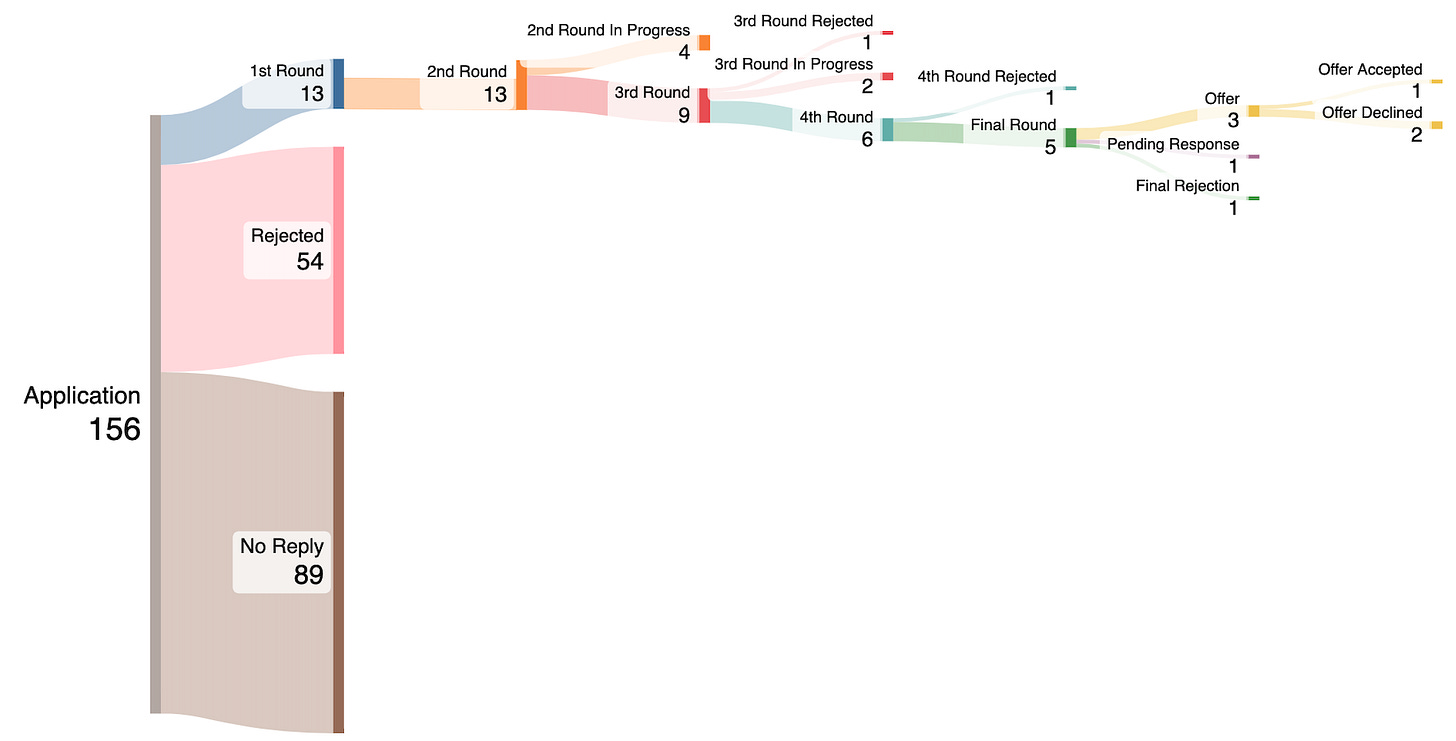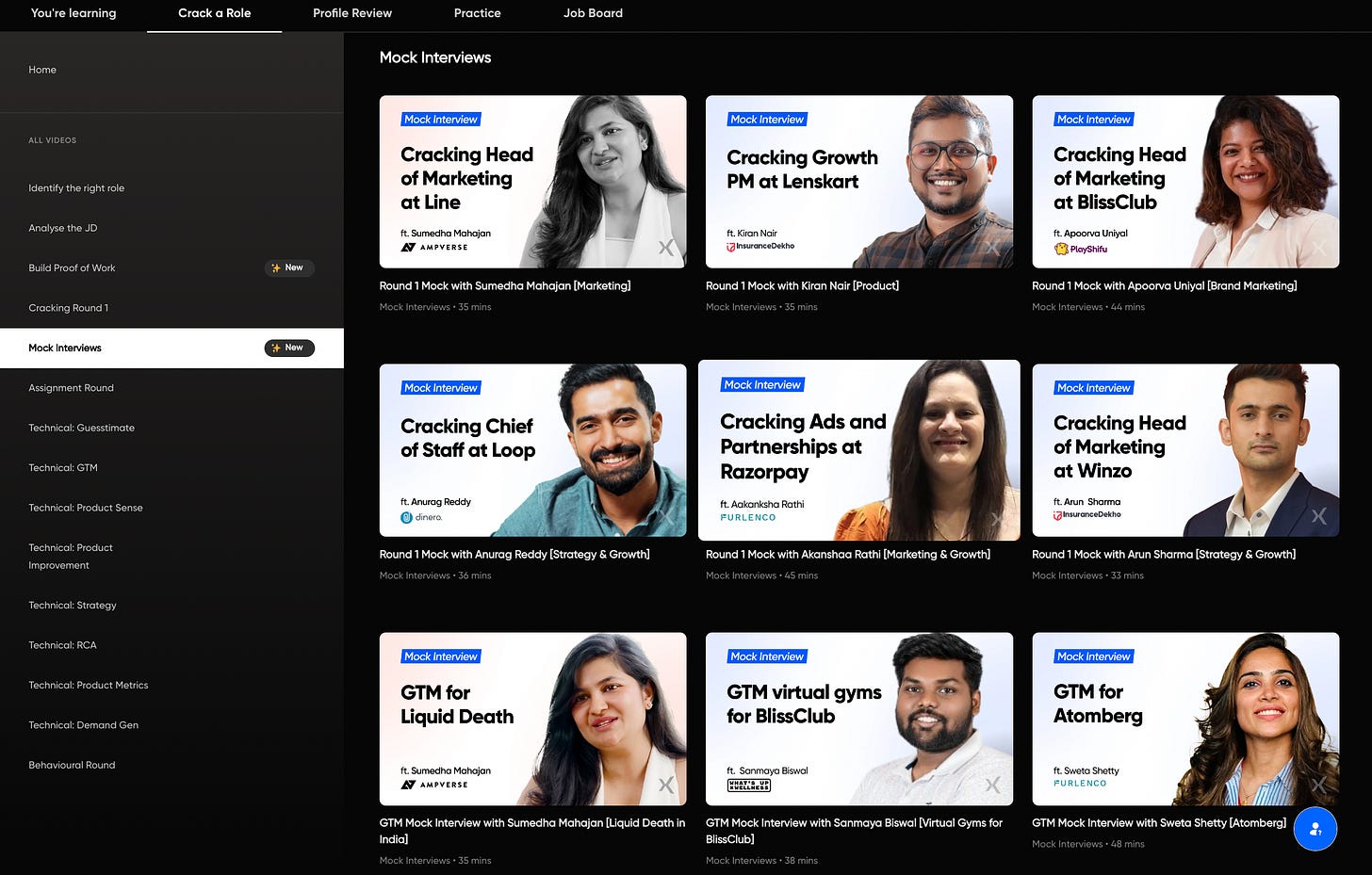It's more sales than science
Job hunting is sales—you’re selling yourself, your skills, and the unique value you bring. Learn how to master this to get your dream role.
This newsletter will be a high-ROI exercise only if you apply what you learn every week. It’s curated to help you advance in your career one step at a time.
Before getting into this, apologies for not sending last week’s edition out - to compensate for that, we will send you two power-packed reads this week. Consistency is everything, for you and us both. Thank you for reading!
Over the years, we’ve cut through a lot of irrelevant advice to uncover the strategies that just work. After working with thousands of members on cracking their dream roles and helping hundreds of companies like Zerodha, CRED, Plum, Rocketlane, Lenskart hire top talent from GrowthX, we’ve seen both sides of the process. We’ve come to understand what helps candidates stand out and land the roles they want. And today, we’re passing on that knowledge to you.
At its core, getting a job isn’t about flooding the market with resumes—it’s about making a compelling case for your value.
Like any good sales process, there are steps involved, and we’re going to break it down in an actionable, results-driven way.
The bottom line:
Focus on what will convince employers, put yourself in their shoes. Ask yourself ‘So what?’ for everything you will tell them.
Demonstrate your ability by building proof of work or addressing the company's problems before the interview.
Set daily goals or partner with someone to keep your job search momentum strong. Momentum is everything.
Most importantly, as you go from early » mid-senior » leadership, the game becomes about referrals.
Let’s be honest: no one is entitled to a job, and the hiring process isn’t always fair. You have to convince someone to trust you with responsibility, a paycheck, and their reputation in return for delivering results.
Read ahead for practical steps to take control of your job search, make meaningful connections, and ultimately land that offer.
Here’s what we’ll cover:
Search for the right role (leads)
Cracking the interview rounds (conversion)
Negotiating the offer
The key throughout is to see things from the employer’s perspective and do whatever will resonate with them the most.
Stage 1: Finding opportunities
A job lead is anything that might turn into a potential opportunity—a position you can apply for, a connection who knows of an opening, or even a freelance project that could lead to paid work.
40% of employers hire fewer than 1 in 10 candidates they interview. This means rejection isn’t personal; it’s just part of the process.
Four major channels that work when it comes to finding the right role -
1. Career pages [on company website]
2. Job Board [LinkedIn & more]
3. Cold DMs
4. Referrals
The most effective way: Referral
As you go towards leadership roles, companies prefer to hire someone they know or someone recommended by a trusted source. If you were hiring, which would you trust more: a recommendation from a colleague or a stack of 200 resumes from strangers? Referrals make the hiring process easier and increase the chances of finding a good fit.
But who you ask for a referral is critical. It definitely cannot be someone you have never interacted with/ worked with. This is why putting yourself in places where you get to build relationships, work on shared projects, add value to discussions and help solve someone’s problem at work is critical. When they know you and have seen you contribute and solve - the chances of them putting their reputation on the line by recommending you to be hired for a role increases.
More than competency
Hiring managers often have limited information when hiring and are looking for more than just competence; they want someone who fits the team’s culture and meets the specific needs of the role.
At every single step and touchpoint, you have to communicate your intent and let your effort shine.
Small effort goes a long way - a leader with 10+ years of experience, while appearing for a Head of Marketing interview round with the Founder of a Series A startup put his Zoom background with the company’s logo in the frame. This helped him start the conversation on a warm note, and they fast-tracked his application. (More on this when he joins them next month)
Stage 2: Prepare for interviews
This is the most critical step, yet neglected by most.
Interview success = 70% Structure + 30% Practice
Exclusive access for GrowthX Members:
Everything you need for your interviews is co-built with members from the fam who have successfully cracked these growth roles.
Building confidence is the key. Prepare for interviews from day 0 of your job search process, not just a day before the interview. It takes multiple rounds of mocks, getting critical feedback and having a command over solving any problem that gets thrown at you. Basically, knowing the structure to solve.
Ask thoughtful questions that show your interest and willingness to solve their problems. Employers are looking for someone who isn’t just qualified but who’s a good fit for their team and culture. Use your interview as an opportunity to demonstrate that fit. For example, let’s say the role you’re applying for requires a lot of cross-functional collaboration. Ask about the team dynamics, the kind of problems they typically face, and how you can help solve them. Showing that you’ve done your homework and that you’re eager to contribute is a game-changer.
Stage 3: Negotiating your worth
Negotiating your salary as a leader involves more than just discussing numbers; it’s about aligning expectations, demonstrating your value, and setting the stage for a mutually beneficial partnership.
1/ Approach the negotiation with confidence
When you’ve verbally accepted an offer but need to revisit the compensation package, it’s important to communicate with clarity and confidence.
Confidence signals that you know your worth and are serious about the role. It sets a professional tone and underscores your commitment to making a significant impact.
You can say “I’m enthusiastic about the opportunity to work with [Company Name]. After reflecting further on the offer, I believe it’s important to revisit the compensation package to ensure it aligns with my experience and the value I aim to bring.”
2/ Emphasize Long-term commitment
As a leader, you’re looking at a long-term partnership with the company. Make it clear that your focus is on contributing significantly over the next few years.
Leaders are expected to drive substantial growth and impact. Demonstrating a long-term perspective shows that you’re committed to investing in the company’s future, not just seeking immediate gains.
But do this only if you are truly invested in the product, mission and the industry. The ecosystem is too small and any evil move will come back in some way or the other, so ensure you act responsibly through the negotiation chat. Highlight what you truly mean and feel without sugarcoating it to offer benefits only.
Sample Approach: “I’ve been carefully evaluating my next career move, aiming for a role where I can stay and contribute meaningfully for the next 3-5 years. I’m eager to bring my expertise to [Company Name] and be a part of its growth journey.”
3/ Highlight your value and previous compensation
Discussing your previous compensation should be done tactfully, focusing on how it reflects your value and experience rather than just a comparison.
Addressing your past compensation helps set a baseline for your expectations, especially if you’ve felt undervalued. It’s essential to frame it as a reflection of your experience and the market value you bring.
This can help - “In my current role, I have felt that my compensation does not fully reflect my contributions and market value. Given my experience and the impact I’ve demonstrated, it’s crucial that my new compensation aligns with my expertise and the value I will bring to [Company Name].”
4/ Keep the focus on mutual benefits
Frame the negotiation as a partnership where both parties are making a bet on future success. Avoid over-justifying or excessive focus on personal needs.
How does it help? Highlighting the mutual benefits of the arrangement reinforces the idea that you’re committed to contributing to the company’s success, which aligns with the company’s goals and expectations.
Always end by saying, “I see this as a mutual commitment. My goal is to focus on solving key challenges and driving growth. Ensuring that the compensation package reflects both my current value and future contributions will enable me to dedicate my full energy and expertise to the role.”
Very Important: These steps will only help and make sense if you truly belive in it. Just using this for the sake of getting a number will not work.
It’s a fairly small ecosystem, ensure you do what’s morally right.
Featured roles this week ✨
Brand & PR Head, Coverfox | Insurance
Growth Manager, Dodo Payments | Fintech
Product Marketing Manager, Saras Analytics | Technology
Marketing Ops, Rockletlane | B2B SaaS
Curated resources for you 🚀
[Event] Decoding a career in Marketing with Head of Marketing, Ampverse.
[Book] Crossing the Chasm, recommended for those building in B2B space
Top discussions - evaluating creative agency’s performance, landing pages, US entity registration & more.
Job searching isn’t easy, and there’s no one-size-fits-all formula. But by taking a strategic approach—one that’s focused on building connections, proving your worth, and staying resilient—you’re already positioning yourself ahead of the pack.
Until next time,
Kshitija
P.S. What do you want us to cover next? Hit reply to share.



